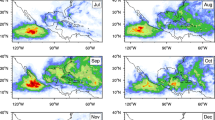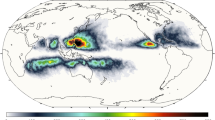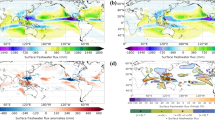Abstract
Water budgets in tropical cyclones (TCs) are computed in the ERA-interim (ERAI) re-analysis and the CNRM-CM5 model for the late 20th and 21st centuries. At a 6-hourly timescale and averaged over a 5\(^{\circ } \times 5^{\circ }\) box around a TC center, the main contribution to rainfall is moisture convergence, with decreasing contribution of evaporation for increasing rainfall intensities. It is found that TC rainfall in ERAI and the model are underestimated when compared with the tropical rainfall measuring mission (TRMM), probably due to underestimated TC winds in ERAI vs. observed TCs. It is also found that relative increase in TC rainfall between the second half of the 20th and 21st centuries may surpass the rate of change suggested by the Clausius–Clapeyron formula. It may even reach twice this rate for reduced spatial domains corresponding to the highest cyclonic rainfall. This is in agreement with an expected positive feedback between TC rainfall intensity and dynamics.






Similar content being viewed by others
References
Allan RP, Liu C, Zahn M, Lavers DA, Koukouvagias E, Bodas-Salcedo A (2013) Physically consistent responses of the global atmospheric hydrological cycle in models and observations. Surv Geophys 35(3):533–552
Allen MR, Ingram WJ (2002) Constraints on future changes in climate and the hydrologic cycle. Nature 419(6903):224–232
Anthes RA (1974) The dynamics and energetics of mature tropical cyclones. Rev Geophys 12(3):495–522
Bender MA, Ginis I, Tuleya R, Thomas B, Marchok T (2007) The operational GFDL coupled hurricane-ocean prediction system and a summary of its performance. Mon Weather Rev 135(12):3965–3989
Boer G (1993) Climate change and the regulation of the surface moisture and energy budgets. Clim Dyn 8(5):225–239
Bougeault P (1985) A simple parameterization of the large-scale effects of cumulus convection. Mon Weather Rev 113(12):2108–2121
Chauvin F, Royer JF, Déqué M (2006) Response of hurricane-type vortices to global warming as simulated by ARPEGE-Climat at high resolution. Clim Dyn 27:377–399. doi:10.1007/s00382-006-0135-7
Daloz AS, Chauvin F, Roux F (2012) Impact of the configuration of stretching and ocean-atmosphere coupling on tropical cyclone activity in the variable-resolution GCM ARPEGE. Clim Dyn 39:2343–2359. doi:10.1007/s00382-012-1561-3
Dee D, Uppala S, Simmons A, Berrisford P, Poli P, Kobayashi S, Andrae U, Balmaseda M, Balsamo G, Bauer P et al (2011) The ERA-interim reanalysis: configuration and performance of the data assimilation system. Q J R Meteorol Soc 137(656):553–597
Frank WM (1977) The structure and energetics of the tropical cyclone i. Storm structure. Mon Weather Rev 105(9):1119–1135
Held IM, Soden BJ (2006) Robust responses of the hydrological cycle to global warming. J Clim 19(21):5686–5699
Huffman GJ, Bolvin DT, Nelkin EJ, Wolff DB, Adler RF, Gu G, Hong Y, Bowman KP, Stocker EF (2007) The TRMM multisatellite precipitation analysis (tmpa): quasi-global, multiyear, combined-sensor precipitation estimates at fine scales. J Hydrometeorol 8(1):38–55
Kang SM, Held IM (2012) Tropical precipitation, SSTs and the surface energy budget: a zonally symmetric perspective. Clim Dyn 38(9–10):1917–1924
Kharin VV, Zwiers F, Zhang X, Wehner M (2013) Changes in temperature and precipitation extremes in the CMIP5 ensemble. Clim Change 119(2):345–357
Kim JE, Alexander MJ (2013) Tropical precipitation variability and convectively coupled equatorial waves on submonthly time scales in reanalyses and TRMM. J Clim 26(10):3013–3030
Knapp KR, Kruk MC, Levinson DH, Diamond HJ, Neumann CJ (2010) The international best track archive for climate stewardship (IBTracs) unifying tropical cyclone data. Bull Am Meteorol Soc 91(3):363–376
Knutson TR, Tuleya RE, Shen W, Ginis I (2001) Impact of co2-induced warming on hurricane intensities as simulated in a hurricane model with ocean coupling. J Clim 14(11):2458–2468
Knutson TR, McBride JL, Chan J, Emanuel K, Holland G, Landsea C, Held I, Kossin JP, Srivastava AK, Sugi M (2010) Tropical cyclones and climate change. Nature Geosci 3:157–163
Knutson TR, Sirutis JJ, Vecchi GA, Garner S, Zhao M, Kim HS, Bender M, Tuleya RE, Held IM, Villarini G (2013) Dynamical downscaling projections of twenty-first-century atlantic hurricane activity: CMIP3 and CMIP5 model-based scenarios. J Clim 26(17):6591–6617
O’Gorman PA, Schneider T (2009) The physical basis for increases in precipitation extremes in simulations of 21st-century climate change. Proc Natl Acad Sci 106(35):14,773–14,777
Pall P, Allen M, Stone D (2007) Testing the Clausius-Clapeyron constraint on changes in extreme precipitation under CO2 warming. Clim Dyn 28(4):351–363
Peixoto JP, Oort AH (eds) (1992) Physics of climate, 1st edn. American Institute Physics, New York
Schenkel BA, Hart RE (2012) An examination of tropical cyclone position, intensity, and intensity life cycle within atmospheric reanalysis datasets. J Clim 25(10):3453–3475
Stocker T, Qin D, Plattner G, Tignor M, Allen S, Boschung J, Nauels A, Xia Y, Bex V, Midgley P (2013) Climate change 2013: the physical science basis. In: Intergovernmental panel on climate change, working group i contribution to the ipcc fifth assessment report (ar5)
Sugiyama M, Shiogama H, Emori S (2010) Precipitation extreme changes exceeding moisture content increases in MIROC and IPCC climate models. Proc Natl Acad Sci 107(2):571–575
Trenberth KE (1999) Conceptual framework for changes of extremes of the hydrological cycle with climate change. Climatic Change 42:327–339
Trenberth KE, Dai A, Rasmussen RM, Parsons DB (2003) The changing character of precipitation. Bull Am Meteorol Soc 84(9):1205–1217
Trenberth KE, Davis CA, Fasullo J (2007) Water and energy budgets of hurricanes: case studies of Ivan and Katrina. J Geophys Res 112(D2):3106. doi:10.1029/2006JD008303
Voldoire A, Sanchez-Gomez E, y Mélia DS, Decharme B, Cassou C, Sénési S, Valcke S, Beau I, Alias A, Chevallier M et al (2013) The CNRM-CM5.1 global climate model: description and basic evaluation. Clim Dyn 40(9–10):2091–2121
Walsh K, Fiorino M, Landsea C, McInnes K (2007) Objectively determined resolution-dependent threshold criteria for the detection of tropical cyclones in climate models and reanalyses. J Clim 20(10):2307–2314
Wang CC, Lin BX, Chen CT, Lo SH (2015) Quantifying the effects of long-term climate change on tropical cyclone rainfall using a cloud-resolving model: Examples of two landfall typhoons in taiwan. J Clim 28(1):66–85
Wright DB, Knutson TR, Smith JA (2015) Regional climate model projections of rainfall from US landfalling tropical cyclones. Clim Dyn 45(11):1–15
Wu W, Chen J, Huang R (2013) Water budgets of tropical cyclones: three case studies. Adv Atm Sci 30(2):468–484. doi:10.1007/s00376-012-2050-7
Yang MJ, Braun SA, Chen DS (2011) Water budget of typhoon Nari (2001). J Clim 139:3809–3828. doi:10.1175/MWR-D-10-05090.1
Acknowledgements
The authors are grateful for Anne-Sophie Daloz for the data provided during its PhD at CNRM. They also address their thanks to the two anonymous reviewers whose comments were helpful in improving the quality of this paper. Observed datas were taken from both TRMM and ERAI databases and the model was run at CNRM/Météo-France. All the data are available at CNRM. Most of the analyses and figures were performed with the NCL and R tools.
Author information
Authors and Affiliations
Corresponding author
Appendix: Technical procedures
Appendix: Technical procedures
1.1 Compositing technique
Composite databases were constructed relative to the TC center at its lifetime-maximum area averaged rainfall intensity. For the ERAI reanalysis, we chose to base the compositing on the observed IBTrACS dataset so that rainfall percentiles could be compared with those obtained for TRMM. For the CNRM-CM simulations, we used the objective TC tracking software developed at CNRM and described in Chauvin et al. (2006). This software was also used in Daloz et al. (2012) for the same simulations as the ones described here. In order to ensure independency in the variables, the choice was made to consider only one occurrence per TC. Since we are interested in extreme rainfall, the lifetime-maximum area averaged rainfall intensity (over the 5\(^{\circ }\times 5^{\circ }\) box surrounding the TC) was searched for and the associated TC occurrence selected. Only TCs south of 30\(^{\circ }\)N are considered and previous occurrence of the TC step must be defined in order to allow computation of the column water tendency as well as the MC component. For observations, the tropical storm level was a necessary condition for selection while for the model, a threshold of 15 m\(s^{-1}\) was considered. In the end, we constructed a database of TC fields for computation of the water budget as a collection of 5\(^{\circ }\times 5^{\circ }\) square boxes centered on the TC centers. The numbers of selected TCs for each dataset are 310 for ERAI, 159 for ERAI-TRMM, 688 for the present simulated climate and 453 for the future.
Moisture and wind are instantaneous prognostics in the models while rainfall, evaporation and column water are accumulated over the last 6 h. Consequently, we calculated the average moisture convergence between the occurrence of maximum rainfall and the previous 6-hourly prognostic. All the water budget terms are representative of the same 6-h period preceding the maximum rainfall. For an exact water budget computation, MC should be calculated at the model timestep and then averaged over the 6 h preceding the maximum rainfall. Unfortunately, this diagnostic is often not available in model outputs and we assume that the fluctuations of wind and moisture within a 6 h period are sufficiently small to be neglected in the 5\(^{\circ }\times 5^{\circ }\) area average.
1.2 Confidence intervals
Figures 1 and 3 have been calculated in the same way, based on the rainfall percentiles distribution. For each TC occurrence selected, a spatial average is performed on each component of the water budget over the 5\(^{\circ }\times 5^{\circ }\) box. Area-averaged rainfall values are sorted in an ascending order and all terms of the water budget are sorted accordingly. A cubic spline is applied to the resulting series. The aim of smoothing is to consider an average of the water budget components inside a rainfall percentile (i.e. the conditional expectation of the component given rainfall). The water budget is expected to be closed as for each percentile all the water budget components are computed from the same TC occurrences and in the same way. To construct confidence intervals of the water budget terms, a bootstrap process is constructed as follows:
-
1.
generate one thousand random samples of N rainfall among N with replacements, N being the number of TC occurrences,
-
2.
class the area-averaged rainfall in ascending order for each sample and sort the other terms with the same ranking as rainfall,
-
3.
cubic spline smoothing of all terms, except rainfall, with 100 equivalent degrees of freedom in order to smooth sample fluctuations due to the following percentile selection,
-
4.
select rainfall percentiles and corresponding smoothed conditional expectations of the other terms,
-
5.
calculate the mean and the 5 and 95% probabilities for each rainfall percentile or conditional expectation of the other budget terms.
The sorting is applied to rainfall, thus the smoothing is not necessary on the rainfall component since the sorted distribution is already very smooth.
For Fig. 5, a slightly different method was adopted. Rainfall percentiles were calculated first for the present and future climate simulations. Then, differences between percentiles were calculated. Indeed, it is not possible to calculate differences between the raw series since the number of selected cases are not the same in present and future simulations. Since we are only considering rainfall, no need for smoothing is required.
For the ratio of MC and evaporation we no longer consider conditional expectations. When considering sub-domains of the 5\(^{\circ }\times 5^{\circ }\) square box, rainfall and the other components of the water budget are not always co-located. This is true not only for evaporation, the spatial structure of which is different from rainfall but also for MC, although its spatial structure is expected to be very similar to the rainfall pattern. The reason for such a shift comes from the way in which we calculated the MC component. Indeed, as we mentioned above, the MC component is computed as the average between its values at t and t−6h timesteps. Thus, the aggregation operates on fields centered on different locations while the rainfall is accumulated over the box centered on the TC at time t. Such shifts in the MC and rainfall components lead to the inability to compute the conditional expectations on sub-domains of the TC. Consequently, the distributions of the relative changes were computed from each water budget component. For rainfall, this is completely coherent with previous computations but it is different for evaporation and MC. The figure aims nevertheless to show that MC behaves like rainfall in a warming climate whilst evaporation does not. Given that MC is the main contribution to rainfall, it can be concluded that rainfall changes follow those of MC. It should be noticed that for ratios, no smoothing was applied as each variable was ranked separately, leading to smooth distributions.
1.3 Degrees of freedom for the cubic-splines
Conditional computation of the water budget to rainfall results in highly variable terms for a given rainfall percentile, due to sampling effects. To reduce the noise associated with this variability a cubic-spline is applied to the raw data before calculating the conditional expectation for each rainfall percentile. This implies the determination as objectively as possible of the degree of smoothness that we wish to apply to data. The choice of the number of degrees of freedom has a strong influence on the width of the confidence intervals shown in the figures related to the water budget. The sorted area averaged rainfall is, by definition, a smooth curve. Thus, it was not smoothed in figures showing the raw budget for present climate. In the other figures related to anomalies we applied the same smoothing as for the other terms. Since we are interested by the mean behavior of the other components as rainfall increases, we wish to consider curves as smooth as possible for these terms, without losing the link with the rainfall distribution. To illustrate the way in which we choose the degrees of freedom, Fig. 7 shows one of the bootstrap samples for the MC term as well as cubic-splines with different degrees of freedom that were applied to the raw data. It is clear from Fig. 7 that a high number of degrees of freedom do not filter the noise enough. With numbers between 10 and 20, the overall shape of the raw data is conserved and noise is substantially filtered. The slope of the curve is better represented at the boundaries of the dataset at 10 than at 5 degrees of freedom. We made the choice in this study to consider 8 degrees of freedom except in Fig. 4 where we used 5.
1.4 Rate of change of water vapor and dynamical convergence
Since water vapor and dynamical convergence are highly dependent one cannot expect that their respective contributions will be additive. Nevertheless, by making some simple assumptions, it may be nearly the case. Indeed, the MC term may be decomposed as follows (Wu et al. 2013):
where the \(\nabla\) operator represents the divergence of the wind vector V or the gradient of the scalar specific humidity q and g is the gravity acceleration (9.81 ms\(^{-{2}}\)).
In their study, Wu et al. (2013) refer to the first term on the right side as the wind convergence part (WCP) and to the second as the moisture advection part (MAP). The second term is of second order compared to the first one and if neglected, one can consider that the relative rate of change of MC is the sum of the relative rates of change of water vapor and dynamical convergence. But, since the terms are vertically integrated, one must be cautious to integrate the dynamical convergence with vertical weights proportional to the lapse rate of change of water vapor. If this is not done, upper level TC divergence will inhibit lower level convergence in the integral. For the computation of the dynamical convergence, we calculated the water vapor lapse rate averaged over space and time. Thus a constant set of vertical weights was applied to the present and future TC composites.
Figure 8a, b show that the relative rate of change of water vapor does not strictly follow the Clausius–Clapeyron formula as would be expected if TCs only experienced an increase in surface temperature. In the scenario, however, advective terms are at play which enhance the water vapour increase (this probably contradicts the assumption of their negligible role in the water budget). In contrast, the dynamical convergence increases at a rate lower than CC (maybe in coherency with fairly little increase in winds). The conclusion of this supplementary analysis is that rainfall increase at rates higher than CC may be explained by changes in dynamics as suggested by (Trenberth et al. 2007) but the respective contributions of each component are not easy to calculate since there is a highly non-linear relationship between thermal and dynamical changes.
Rights and permissions
About this article
Cite this article
Chauvin, F., Douville, H. & Ribes, A. Atlantic tropical cyclones water budget in observations and CNRM-CM5 model. Clim Dyn 49, 4009–4021 (2017). https://doi.org/10.1007/s00382-017-3559-3
Received:
Accepted:
Published:
Issue Date:
DOI: https://doi.org/10.1007/s00382-017-3559-3






